Property History
The narrative presented below was created by drawing on recent research on various archive sites and by referencing material from a number of local website sources. If you happen to have additional historical information or photos that would enrich the story, or if you believe there is a correction needed, please contact the site administrator to submit and discuss.
Think You Know Carlyle Heights?
Carlyle Heights wasn't always Carlyle Heights.
Before the conversion to condos in 2004, there were two previous rental property brands at this location stretching back to 1973. Many residents are aware of the previous life of the property that was an apartment complex called Morningside Chase, a residential property then popular with the Atlanta gay population, and with an earned reputation of mixed reviews.
But what about before that?
Prior to Morningside Chase and the previous apartment rental brand it existed as before that, our piece of property survived nearly being flattened into a new interstate branch (just like all of the Viginia-Highland, Piedmont Heights and Lenox-Morningside Park neighborhoods.) Luckily, various organizations in Atlanta, such as The Atlanta History Center, Emory, Georgia State University and the Atlanta Journal-Constitution keep extensive historical records in their archives. Documentation generated over the decades by Atlanta newspapers, the city, Fulton County, and by various civic and neighborhood organizations, are collected and made available for research.
We've recently been digging through the archives...
We've uncovered some interesting details! There's a clearer picture of the property history now than we've had before. Please enjoy reading some of the rich detail.
We'll start back at the turn of the century.
Pre-Property Development (1915-1972)
....................................................................................................................................
At the turn of the century the city of Atlanta more or less ended at the south end of Piedmont Park. A number of roads continued north past the park land and the area around Ansley Mall was a town called Easton, now mostly forgotten, which was home to a Walker’s Mill (also known as Jones’ Mill) which ginned the local farmer’s cotton and ground their corn.
The unique neighborhoods we know today, Ansley Park, Piedmont Heights, Sherwood Forest, Lenox-Morningside had not even been subdivided from raw land or annexed into the city of Atlanta yet. The Carlyle Heights lot was raw land as well.
From Wikipedia
The first record of settlement of the area that is now Virginia–Highland was in 1812, when William Zachary bought and built a farm on 202.5 acres (0.819 km2) of land there. In 1822 he sold his farm to Richard Copeland Todd (1792–1850). Todd's brother-in-law Hardy Ivy settled in 1832 in what is now Downtown Atlanta and the road between their two farms came to be known as Todd Road (a portion of which still exists in VirginiaºHighland)."Nine Mile Circle"[edit]
In the 1880s, Georgia Railroad executive Richard Peters and real estate developer George Washington Adair organized the Atlanta Street Railway Company.[7] Their first project was the Nine Mile Trolley, which started serving the area sometime between 1888 and 1890. At first, patrons used this streetcar line to visit "the countryside" outside the city, and the line stimulated later development in the area. Adair built his home at 964 Rupley Drive (still standing and divided into upscale apartments). The iconic curves in the street at the intersections of Virginia Ave. with N. Highland and Monroe are remnants of the trolley line, which required gentle curves.
Map after map created by the city through the decades shows our property remained undeveloped. On a few maps one or two structures are shown but for the most part it was a wild, drainage run off area leading down to the Clear Creek Piedmont Park watershed tributary in what is now the new Piedmont Commons section of the park.
1892
Hand drawn map of Piedmont Park as developed for the 1897 Piedmont Exposition event. The general area of Carlyle Heights, clearly raw forest, is marked with the pin.
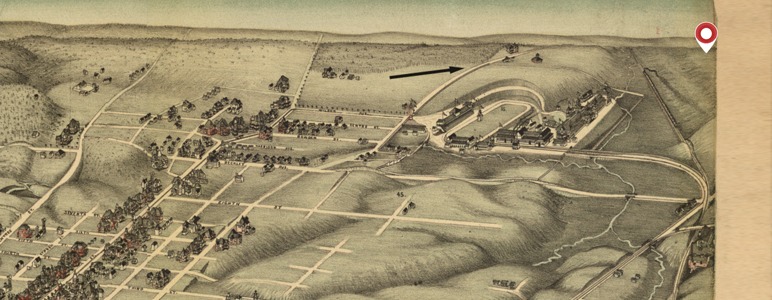
1917
The Morningside/Ansley area was part of a township called Easton, outside the Atlanta city limit. This map shows that the city limit was the south end of Piedmont Park at 10th.
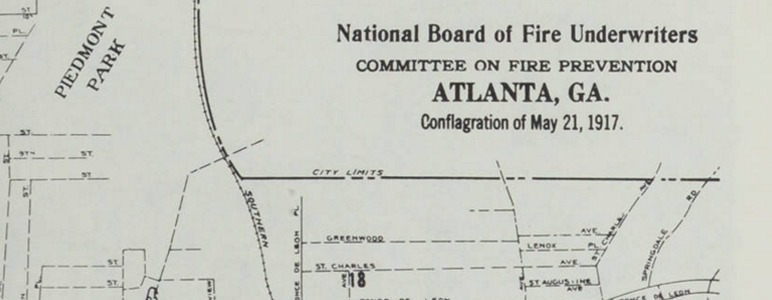
1920
Newspaper announcement of brand new subdivision called Morningside under construction.
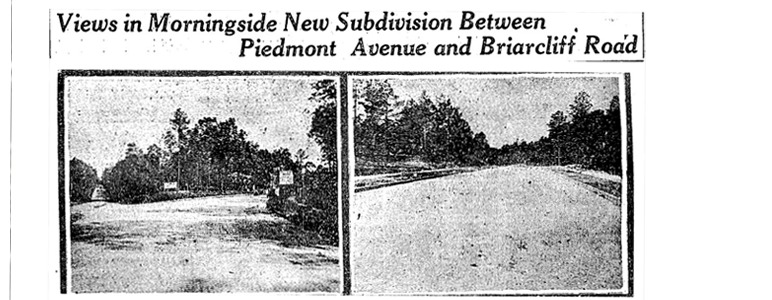
1921
Atlanta Newspaper announcement describing portions of land that the City of Atlanta was annexing. Our plat map section 52 is shown here, perhaps one of the first times, with no development on it as raw land. Note: during this period of time Monroe Drive was called North Boulevard.
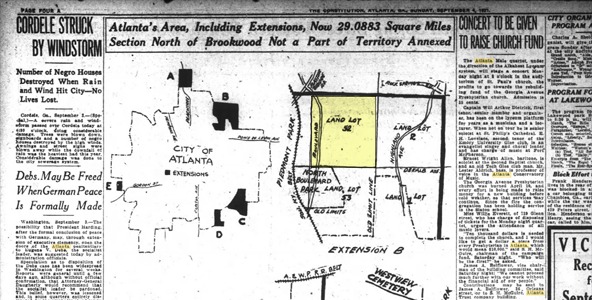
1927
A composite map of the land topography of 1927 overlaid with a later map of streets and structures as a reference. A few small structures appear on the ridge toward the back half of our current property boundaries.
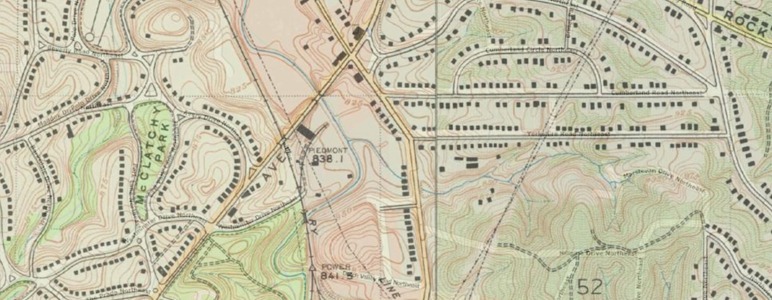
1935
Map of Atlanta major streets. Our neighborhood area is shown here, but the Hillpine, Carlyle Heights and Yorkshire plots and streets are not shown, either because they are lesser streets or simply undeveloped yet.
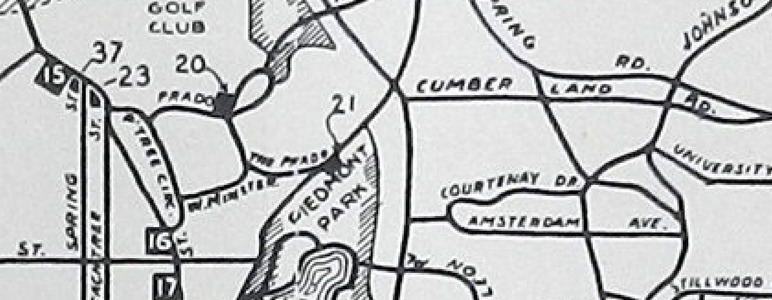
1940
Map of Atlanta street car routes. Again, our neighborhood area is shown here, but the Hillpine, Carlyle Heights and Yorkshire not depicted.
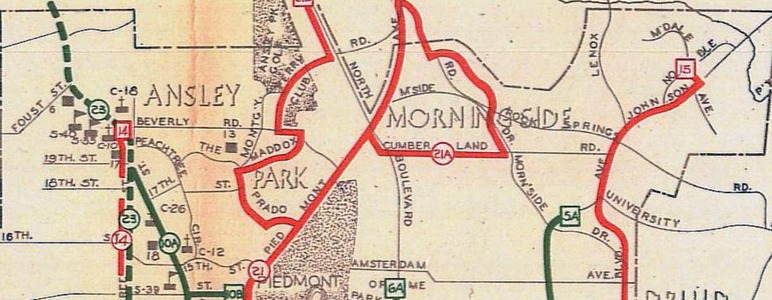
1949
Part of a large aerial image taken during in the late 1940s captured the original development of the Sherwood Forest subdivision. In the image you can clearly see that the Carlyle Heights and Hillpine lots are undeveloped, thickly forested green space.
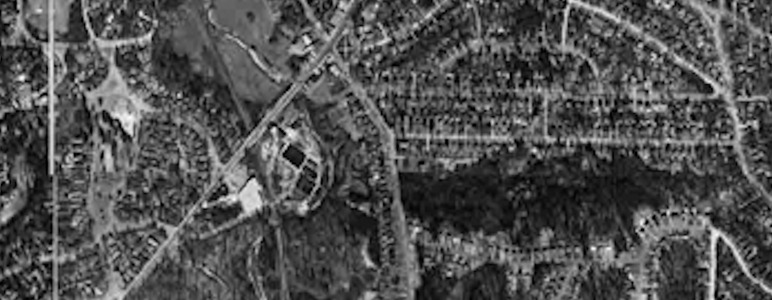
1952
A map, updated in 1963, reflecting the street layouts as we know them now. Hillpine Park's lot is now present. Our lot is still shown as undeveloped land.
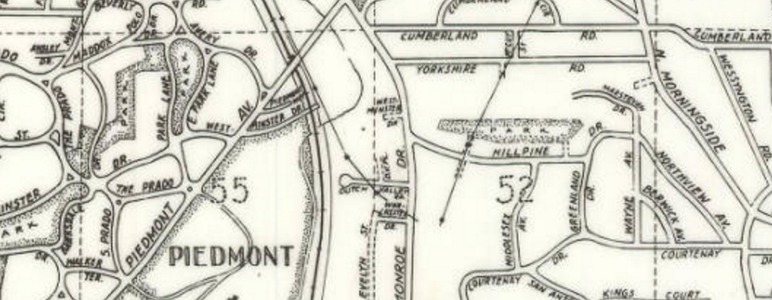
1965
Aerial photo showing our land lot. Houses are appearing on Yorkshire and one or two structures are show on our lot but for the most part the land remains undeveloped.


1968 - Letter to Editor
............................................................................
The Atlanta Constitution............................................................................
Oct 10, 1968; pg. 4
City Should Keep Wooded Areas
From: Mrs. Josephine H Wills
ATLANTA — Mr. Fink's letter to Mr. Harold Martin, printed in the Oct. 1 Atlanta Constitution, is of great interest to me. The utter lack of provision for suitable areas to preserve the birds and other wildlife around the city of Atlanta is frightening —to state it mildly.
There are still some undeveloped small wooded tracts of land within the actual city limits which could et aside as bird sanctuaries wildlife refuges —if only the parks department or whoever controls and decides these matters would take steps to have them officially designated.
For many years I have tried to interest various groups such bird clubs, historical societies and the city parks department in 22 acres of undeveloped wooded land, facing on Monroe Drive, NE and running parallel to Hillpine Drive and Yorkshire Road for almost 2000 feet, almost in the heart of the city.
Actually, 6.2 acres of this land were given to the city many years ago, but the city refused to accept responsibility for the area as a designated park. However, the land still stands, beautiful in its "undeveloped" state, thick with both large and small trees and heavy underbrush—a haven for small wildlife and a natural bird sanctuary.
The other 15.8 acres belong to a speculator who through the years attempted to rezone this acreage from residential to commercial, institutional, and, now pending, is an apartment petition, which would be for more than 200 units on eleven acres.
He has included in his density calculations for his apartment project 6.2 acres of park land, we greatly fear the Board of Aldermen will agree to this massive project. This speculator has been enjoined by the court to leave the park area untouched, but we are afraid he will assume to his own use, these reserved once his project is initiated.
There are hundreds of birds of every known type native to the Piedmont area and the migratory birds come by the thousands. There are rabbits, squirrels, raccoons, o'possums other small animals living in this wooded area, and I am thankful my child has had the privilege of roaming the forest, gathering and identifying botanical specimens she would never have known, seeing small animals in their natural habitat, luxuriating in the magic of the changing seasons, all of which would have been impossible without this priceless, small natural forest which adjoins our property.
These 6.2 acres are completely surrounded by private property, an island, with no en-trances nor exits from any streets, which makes it a perfect sanctuary. There is also a small stream.
I sincerely hope the Constitution Lake area will be saved, as well as Hipline Park.
- JOSEPHINE H. WILLS.
Reproduced with permission of the copyright owner. Further reproduction prohibited without permission.
1970
Atlanta North East Ultimate Development Plan map. Carlyle Heights and Hillpine Park areas designated as "open and public space."
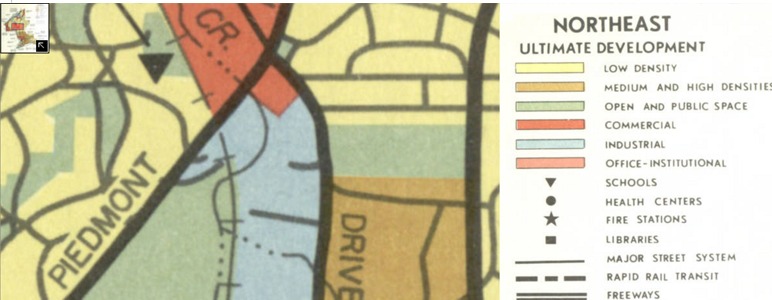
1970
Map of one of four possible routes, shown as the red line, for the hotly contested and neighborhood-defeated, proposed I-495 interstate spur that the Georgia Department of Transportation tried to get approved in the 1960s and 1970s.
This route would have demolished the homes and businesses in the the Freedom Parkway area, Virginia-Highlands, Morningside-Lenox Park, Morningside Nature Preserve, areas of Cheshire Bridge, and Lindrige-Martin Manor.
You can see the route goes through the area that includes the back of our property.
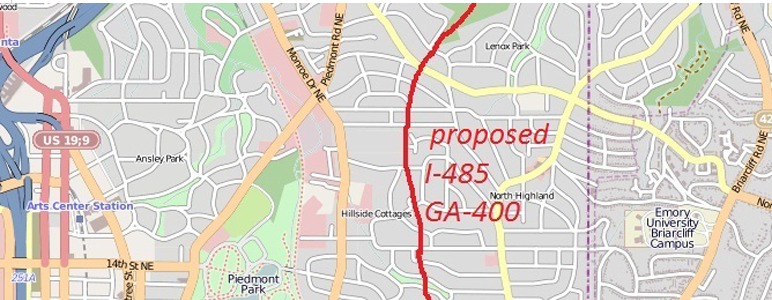
From Wikipedia:
The Atlanta Freeway Revolts
There have been multiple freeway revolts in Atlanta, Georgia. However, the longest and most famous example of Interstate opposition is against I-485 and the Stone Mountain Freeway through Intown Atlanta, lasting over 30 years, from the early 1960s until the final construction of Freedom Parkway on a small portion of the contested routes in 1994.[1]
One was a north-south freeway parallel to, and 2–3 miles (3.2–4.8 km) east of today's Downtown Connector (I-75/85), connecting the southern end of today's Georgia 400 with I-675 at the southeast Perimeter.In 1964 the Georgia Highway Department (GHD) announced plans to build I-485. In May 1965, the Morningside Lenox Park Association (MLPA) was formed to fight the highway. MLPA hired planners who suggested an alternate route E, (map) roughly along the BeltLine from Ponce de Leon Avenue north to Ansley Mall and from there alongside Piedmont Road north to today's I-85/GA-400 interchange. In July 1965 a dueling civic association, the Morningside Monroe Civic Association (MMCA), was formed to fight Route E. In February 1966 the highway department definitively chose the original route (route B) through Morningside.[2]
MLPA filed a lawsuit in October 1966 to try to stop construction and was denied; the appeal was denied in June 1967.
The freeway revolt strengthened neighborhood organizations in Atlanta, which to this day exert relatively more influence in city decisions compared to other major US cities.[6]
As a result of the self-organization of numerous neighborhood association groups that was done to protest and ultimately block the proposed internet spur, Atlanta moved to establish a system of Neighborhood Planning Units (NPUs) that were granted influence over how development zoning and other matters were handled, effectively allowing NPUs to drive how the character of their particular neighborhoods was maintained or in what direction it evolved.
Carlyle Heights as part of Morningside-Lenox Park falls under the auspices of Atlanta Neighborhood Planning Unit F.
Initial Rental Property Development (1973-1978)
............................................................................................................................................................
Original development of the first generation rental property version of Carlyle Heights was initiated in 1972 and completed in 1973.
The property owner/developer hadn't always envisioned it it as a residential lot though. A man named Eugene Erwin, he both owned a construction company and played violin for the Atlanta Symphony. Mr. Erwin had purchased the property around 1958-9 before the property value intown skyrocketed with population growth. At the time of purchase it was undeveloped green space, considered part of the same area as Hillpine Park. It was zoned as 'undeveloped' by the city planning bodies and Board of Aldermen.
Mr. Erwin had tried multiple times to get the property zoned for commercial development, and for industrial use, all of which were denied by the Board of Aldermen. Eventually he requested a zoning change that would allow him to build a rental property. Finally, he got a zoning variance approved to develop residential rental property.
In 1973 The Atlanta Journal published an article about Mr. Erwin's construction project on Monroe, highlighting the choice to use steel framing on the remaining buildings after there was a small fire at one of the in-progress buildings.
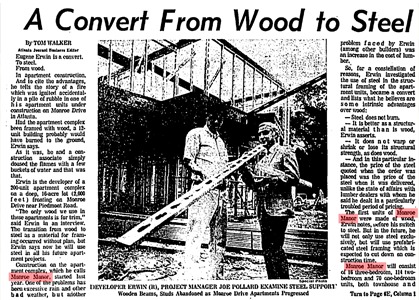
It was in this very article the first reference to the first name for the property was put in print: Monroe Manor.
Here is the full article:

.............................................................................................
.............................................................................................
A Convert From Wood to Steel
By TOM WALKER
The Atlanta Constitution (1946-1984) Jul 29, 1973; pg. lE
Eugene Erwin is a convert. To steel. From wood.
In apartment construction.
And to cite the advantages, he tells the story of a fire which was ignited accidentally in a pile of rubble in one of his apartment units under construction on Monroe Drive in Atlanta.
Had the apartment complex been framed with wood, a 12-unit building probably would have burned to the ground, Erwin says.
As it was, he and a construction associate simply doused the flames with a few buckets of water and that was that.
Erwin is the developer of a 200-unit apartment complex on a deep, 16-acre lot (2,000 feet) fronting on Monroe Drive near Piedmont Road.
"The only wood we use in these apartments is for trim," said Erwin in an interview. ”The transition from wood to steel as a material for framing occurred without plan, but Erwin says now he will use steel in all his future apartment projects.
Construction on the apartment complex, which he calls Monroe Manor, started last year. One of the problems has been excessive rain and other bad weather, but another faced by Erwin (among other builders) was an increase in the cost of lumber.
SO, for a constellation of reasons, Erwin investigated the use of steel in the structural framing of the apartment units, became a convert and lists what he believes are some intrinsic advantages over wood:
— Steel does not burn.
— It is better as a structural material than is wood, Erwin asserts.
— It does not warp or shrink or lose its structural strength, as does wood.
— And in this particular instance, the price of the steel quoted when the order was placed was the price of the steel when it was delivered, unlike the state of affairs with lumber dealers with whom he said he dealt in a particularly troubled period of pricing.
The first units of Monroe Manor were made or wood, Erwin notes, before his switch to steel. But in the future, he will not only use steel exclusively, but will use prefabricated steel framing which Is expected to cut down on construction time.
Monroe Manor will consist of 16 three-bedroom, 114 two-bedroom and 70 one-bedroom units, both townhouse and garden-style units, ranging in size from 850 square feet for ones and 1,600 square feet for threes, and in price from $225 a month for ones and $415 for the threes.
Erwin is also considering the condominium concept for a number of the units, "If there Is enough interest."
Of steel framing, Erwin says: “I think It will appeal to prospective renters and especially to buyers. The main advantage to its use is where you're duplicating a unit, or using modular construction."
Erwin said every precaution is being taken to prevent any sound transfer problems , that may arise from the use of the steel. Pipes, for example, are being insulated and walls insulated.
Sound is of special interest to Erwin the person as much, if not moreso, than as a builder. He is also a professional musician, who started out as a career violinist In Cleveland, Ohio, and took up building because it met family expenses better.
But music remains Erwin's "labor of love," and he still performs professionally in musical shows which come through town, in string quartets and, until It went to a virtual full-time status, with the Atlanta Symphony.
The tract on which Monroe being built was purchased by Erwin about 15 years ago, and he cites this as one reason why he Is able to build this type of apartment that close to downtown Atlanta. On the market today, this large a tract would cost so much that only a high-rise ; would be the "highest and best use" at that site, Erwin argue.
As a builder, Erwin has very definite ideas about what should go into an apartment. He bases these ideas on the belief that the apartment dweller of today is not just a transient, en route to becoming a homeowner —not necessarily, at least. The apartment, in short, has become a full-time way of life for many persons, and these people are more likely to turn to the condominium if they choose to purchase a dwelling place than to a single-family house.
For example, Erwin says, his units will contain washer-dryer appliances. These are more important than dish washers, which are about standard items now, because In the absence of a clothes washer, the apartment dweller would have to go out to a resident washateria or to a commercial business. In either case, it causes the person wanting to wash clothes to out, often at night, It is simpy an inconvenience, Erwin believes and is not altogether a safe practice these days.
The same reasoning holds for the use of such things as self-cleaning ovens: namely, to provide for the apartment or condominium resident the amenities he wants because he will go elsewhere if they aren't available.
Looking ahead, Erwin said he plans to begin construction on 28 acres at Glenwood and 1-20 in Dekalb County when Monroe Manor is completed. There, too, he will use steel framing, using the lessons he has learned at the Monroe Drive location.
Erwin believes his use of steel framing in apartments is one of the first uses, if not the first, in metro Atlanta, He doesn't know of any other use of steel where wood Is usually used, but he attests to the increased interest by other builders in the concept, based on the number of visits he has received. The process has been used in other cities, Erwin notes, and he fully expects it will become more common in Atlanta in the future.
Purchased from the Atlanta Journal-Constitution archives. Reproduced with permission of the copyright owner. Further reproduction prohibited without permission.
From there, it wasn't long before construction was complete and the property footprint we still recognize today is visible from aerial photos take in 1978. Compare the same photo shot by the same aerial photography company taken in 1972, prior to start of construction, to the 1978 photo when construction had been completed for 5 years.
1972

1978

Despite the newspaper press he earned during construction and the successful completion of the development and several years of leasing units the story was not all roses.
It wasn't long before Mr. Erwin realized that managing a complex full of tenants who all had high expectations for services in a complex called Monroe Manor and marketed as a luxury property.
An article appeared in the paper describing an organized lessee rent withholding campaign by a group of tenants in an effort to force an improvement of amenities and services.
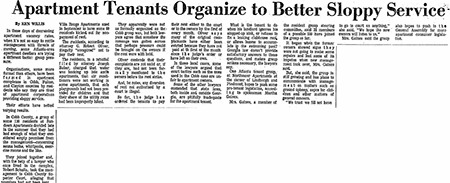
That wasn't the only trouble Mr. Erwin found himself navigating in 1978.
Monroe Manor was listed in the paper as up for auction later in 1978, taken from Mr. Erwin by the city to satisfy a large, outstanding tax debt, which Fulton county was auctioning off on behalf of the city.
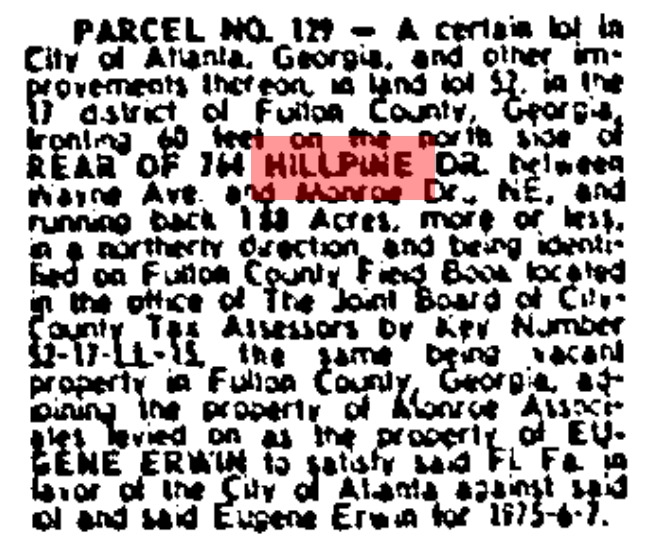
An uncermonious end to Eugene Erwin, owner of the Eugene Erwin Construction Co. and Symphony quality violinist, as the proprietor of Monroe Manor.
We've been able to uncover a print ad for Monroe Manor that was published in the Georgia Medical Journal in the late 1970s. The new units on the property were being marketed to medical professionals and medical students. Note the logo, reflective of the era.
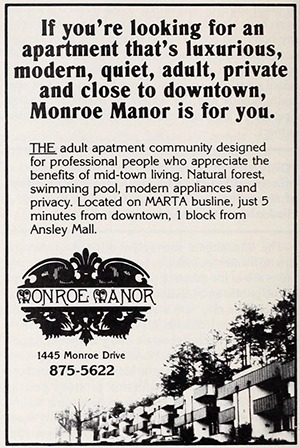
The exact dates of transfers between the companies that represent the chain of ownership during the period between 1978 and 1983 are a little fuzzy. As time allows we'll continue filling in detail gaps and locking down dates to continue building out the narrative timeline.
What we do have is a chain of ownership summary, listing the succession of companies that held the still-operating Monroe Manor, referenced in a bankruptcy case law summary article.
The summary states that in 1983 a company called TM Monroe Manor Associates, Ltd. a Georgia limited partnership formed to own and operate an apartment complex. The property was purchased by TM Monroe Manor Associates, Ltd. from First Equities Corporation for $8,000,000, who had purchased the property from Belcore Associates, Inc. for $8,000,000.
The article does not list the dates of ownership other than the 1983 establishment date of TM Monroe Manor Associates, Ltd. so we'll have to fill in those details at a later time as they are uncovered.
The bankruptcy case law article, found on a website called CaseText.com, describes the bankruptcy filing circumstances of TM Monroe Manor Associates, Ltd. which had certain assets, namely Monroe Manor, that needed to be valued by the bankruptcy review judge. The liquidation of assets and handling of debt was complicated and encumbered by a existing 'wrap around' deed on Monroe Manor held by Belcore Associates to secure debt, apparently passed through the transfer of property from Belcore to First Equities Corp. to TM Monroe Manor Associates, Ltd.
Interestingly, the TM Monroe court case had such unusual contours that it became precedent setting and has been used as a support example in bankruptcy cases around the country and the world many, many time and is even referenced in law case study text books.
The case has even shown up referenced in the published Master's Degree dissertation of a Hong Kong man:
Realization of Mortgage Rights Amid PRC Bankruptcy Proceedings"In re TM Monroe Manor Assocs., the debtor was proposing to convert a substantial portion of Beclore’s (the secured creditor) claim into a limited partnership interest in the reorganized Debtor by creating a special partnership class to be held solely by Belcore. The court held that, “According to the legislative history of 11 U.S.C. 1129, unsecured notes as to the secured claim or equity securities of the debtor would not be considered an indubitable equivalent.
Author: Yu, Yueting
Date: 2007
A thesis submitted in partial fulfillment of the requirements for the degree of Master of Philosophy in Law at the University of Hong Kong
The securities offered were a high risk limited partnership in the Debtor, and there was no probable market in which Belcore could liquidate this tenuous interest.6 Therefore, the court held the Plan was not completely compensatory and rejected the Plan."
So that's twice that the 1445 Monroe Drive property has been involved in the adjudicated discharge of debt, first taken from Eugene Erwin by the City of Atlanta for back taxes and auctioned off, and then years later involved in a fight over the valuation of assets in a bankruptcy case.
Succession of ownership:
Belcore Associates, Inc.
First Equities Corporation
TM Monroe Manor Associates, Ltd.
Morningside Residential LLC
Monroe Manor was rebranded Morningside Chase and its popularity among Atlanta's midtown area gay community continued. It was known as 'gay friendly' and had a reputation for being a little wild. Some of the more uninhibited residents had a tendency to disregard the sensibilities of others leading to a reputation, rooted in fact, but taking on a a life of it's own.
Perhaps unsurprisingly, Morningside Chase, "long known as the gay complex", became the subject or support detail of articles several times in the Southern Voice, Atlanta's now defunct LGBT newspaper.
One Morningside Chase involved narrative that spanned multiple articles was the publicizing and debate of a letter sent to residents by the management company, Belcore, attempting to curtail public displays of affection, which some residents interpreted to mean suppressing gay casual contact in public, and others took to mean attempting to control public inappropriate contact. Quotes and characterizations from both sides are presented.
1993
Atlanta—Has one of Atlanta’s most gay/lesbian friendly apartment complexes turned against the community?
Some residents at Morningside Chase, long known as a “gay complex," think so, and they are concerned that recent events at the complex, including a letter from the property manager telling tenants to stop “public displays of affection" in the pool area, are evidence of a veiled attempt to drive them out
But the managers of the apartment complex strongly deny that they are trying to discriminate against gay or lesbian tenants and say the letter was prompted by complaint from tenants, most of whom were gay.
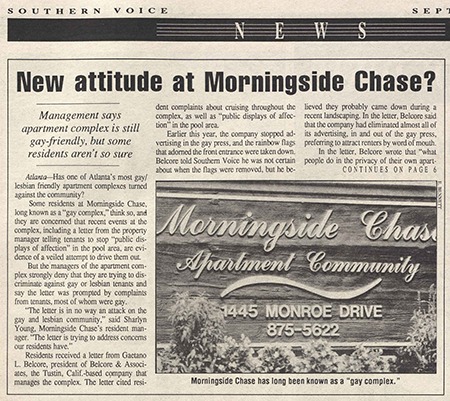
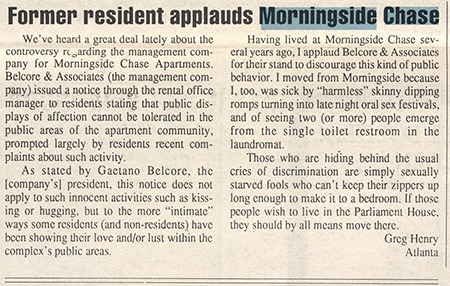
Not all of the news in the Southern Voice about Morningside Chase was lascivious or involved community protesting (a theme we saw in the 1970's article when the renters did a coordinated rent withholding that made papers in order to force Eugene Erwin to improve conditions and amenities...)
1993
This article describes a unique fundraising event for AIDS charities.
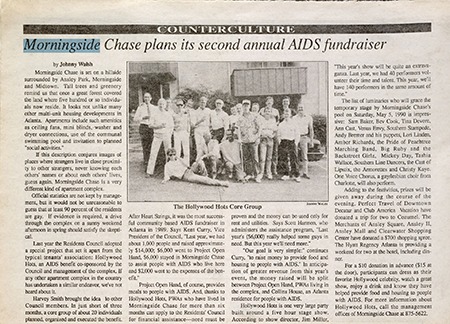
Condo Conversion Era (2003-2004)
............................................................................................................................................................
Developer Tony Rogowski operating as Morningside Chase LLC began a renovation project in 2003, completed in 2004, as part of a conversion of the property from rentals into condominiums. This would become Carlyle Heights.
From a local real estate listing site:
"Carlyle Heights is a garden-style condominium community comprised of 3-story mid-rise condominiums and 2-story town homes. The property is located at 1445 Monroe Drive NE in Midtown-Ansley area of Atlanta. Originally built in 1975 as apartments called Morningside Chase. The property was completely renovated in 2003-2004 and converted into a condominium. There is a mix of one, two, and three bedroom floor plans.
From First amendment Declaration First Amendment:
Carlyle Heights Investors, Inc., a Georgia corporation (certain improvements located on the Additional Property being submitted to the Condominium, prepared by Innovo, Inc. is Carlyle Heights sits on Property Land Lot 52, in the 17th District of Fulton County, consisting of an area of 8.88 acres. There are shared area of right of way with adjacent properties, Ga. Land Surveying Co., Inc. dated December 31, 2003 was filed in Condominium Plat Book 16, Pages 155-156, Fulton County, Georgia Records; May 9, 2004, was recorded in Deed Book 37636, Page 168, et seq., Fulton County.
............................................................................................................................................................
We hope you've enjoyed this assembly of historical references to how our property fits in to Atlanta and Midtown history and how Carlyle Heights came to be. As we consider the future of the property and in what ways to invest in upkeep it is useful to consider not just what we see as well look around the property as it is now but also have an understanding of the bigger picture to help inform a longer view toward the future.
Pages
- Home
- Property Fact Sheet
- Property History
- Association Business
- Board Meeting Records
- Financials
- Insurance Docs
- Leasing
- Forms
- Board of Directors
- Board of Directors
- Capital Repair Project
- Disclosure Statements
- Capital Repair Loan AMORT Schedule
- Community Meetings
- Communications Archive
- Newsletters
- Governing Documents
- View: Articles Of Incorporation
- View: Declaration Of Condominium
- View: By Laws
- View: Declaration of Amendments
- VIEW: Property Map & Floor Plans
- VIEW: Floor Plans D Bldg
- View: Statement of Condition
- VIEW: Rvs'd Stmt Condition
- Policies & Guidelines
- Prospective Buyer Information
- Prospective Buyer Information
- Prospective Buyer FAQ
- Breezeway Assessment Amortization
- Capital Repair Loan AMORT Schedule
- Owners' FAQ
- Maps & Floor Plans
- Member Directory
- Municipal Info
- Useful Contacts
- HIDDEN: Board Only
- Board Executive Session Minutes
- Breezeway Project Accounting
- Capital Repair Project Documents
- Contracts
- Legal Opinions
- Morningside Woods Dispute
- Individual Work Pages
- Possible Future Webpages
- Site Plan, Dev, UX, Legal


